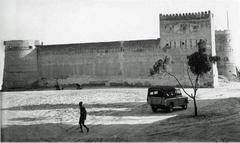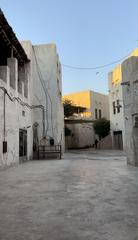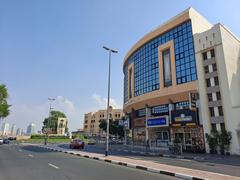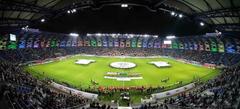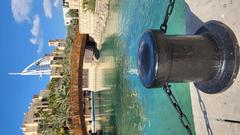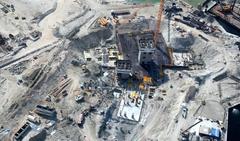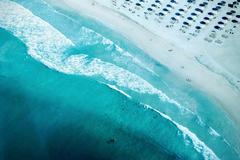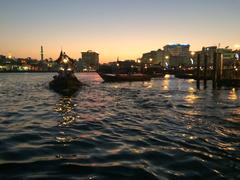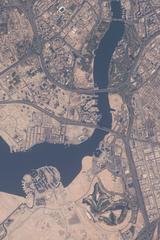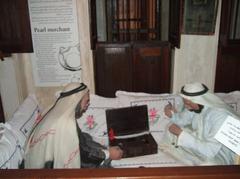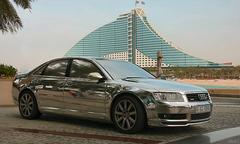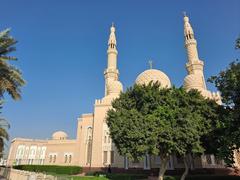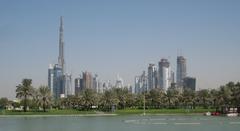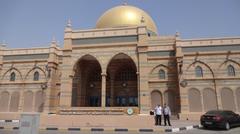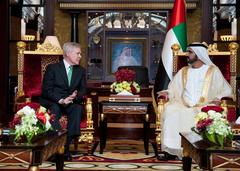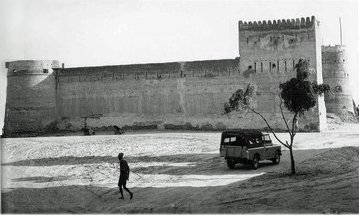
Al Fahidi Fort Visiting Hours, Tickets, and Dubai Historical Sites Guide
Date: 14/06/2025
Introduction
Al Fahidi Fort, Dubai’s oldest surviving structure, stands as a lasting symbol of the city’s rich heritage and transformation. Built in 1787, the fort initially served as a defensive stronghold guarding Dubai Creek—a vital artery for commerce, fishing, and pearl diving. Over the centuries, Al Fahidi Fort has evolved from fortress and royal residence to arsenal, prison, and, since 1971, the home of the Dubai Museum. Today, while renovations temporarily limit interior access, the fort and its surrounding historical district remain essential destinations for anyone seeking to explore Dubai’s vibrant past (Dubai Ticket Expert; Exploring Emirates; UAEstories).
This guide details Al Fahidi Fort visiting hours, ticketing, architectural and cultural significance, accessibility, travel tips, and highlights from the nearby Al Fahidi Historical Neighbourhood. Whether you’re a history enthusiast, cultural explorer, or visiting family, this resource ensures you make the most of your visit to one of Dubai’s most treasured heritage attractions (Dubai Culture).
Table of Contents
- Origins and Historical Evolution of Al Fahidi Fort
- Architectural Features and Restoration
- Al Fahidi Fort Visiting Hours, Tickets & Accessibility
- Exploring the Al Fahidi Historical Neighbourhood
- Practical Tips for Visitors
- Nearby Attractions
- Frequently Asked Questions (FAQ)
- Conclusion and Summary
- References and Further Reading
Origins and Historical Evolution of Al Fahidi Fort
Constructed in 1787 at the southern edge of Dubai Creek, Al Fahidi Fort was designed to defend against rival tribes and maritime threats, safeguarding the city’s nascent trading post (Dubai Ticket Expert; Exploring Emirates). Its robust construction—utilizing coral stone, gypsum, and palm wood—reflects traditional Emirati building techniques and the ingenuity of Dubai’s early settlers (UAEstories).
Throughout its history, the fort served multiple roles. It functioned as a center of governance, royal residence for the Al Maktoum family, arsenal, and prison, underscoring its flexibility and pivotal status in Dubai’s urban and economic life (Gulf News; Arabia Horizons; Travelers Enthusiasm). The fort’s presence encouraged settlement and commerce, supporting the growth of Old Dubai’s commercial hub (Protocol Dubai).
With the modernization of Dubai following the oil boom, the fort’s military purpose diminished. Recognizing its heritage value, Sheikh Rashid bin Saeed Al Maktoum led its restoration, and in 1971, the site was inaugurated as the Dubai Museum. This transformation solidified the fort’s status as a guardian of Dubai’s collective memory, tracing the city’s journey from fishing village to metropolis (Exploring Emirates; Travel Asker).
Architectural Features and Restoration
Al Fahidi Fort showcases the resilience and adaptability of Emirati architecture. Its thick walls—over a meter in some places—were built from coral rock and gypsum, providing insulation against Dubai’s harsh climate (Soluap; Memphis Tours). Palm wood and imported teak supported beams and doors, while palm frond (areesh) structures demonstrated adaptation to local conditions.
Distinctive features include three corner watchtowers, a central courtyard, and imposing wooden entrance doors with brass spikes. The fort’s square design, with defensive battlements and cannons, exemplifies the military architecture of the era (Dubai Travel Guide). The underground galleries—added during the 1995 museum expansion—allow for immersive, climate-controlled exhibits that showcase Dubai’s development.
Preservation efforts, including major restorations in 1995 and 2021, have focused on historical accuracy through traditional materials and craftsmanship, ensuring the fort remains both authentic and accessible for future generations (Protocol Dubai; Memphis Tours).
Al Fahidi Fort Visiting Hours, Tickets & Accessibility
Current Status and Visiting Hours
As of June 2025, Al Fahidi Fort (Dubai Museum) is temporarily closed for renovations that began in 2021. Visitors can still enjoy the exterior and explore the surrounding Al Fahidi Historical Neighbourhood (Travel to Dubai). When operational, standard opening hours are:
- Saturday–Thursday: 8:30 AM – 8:30 PM
- Friday: 2:30 PM – 8:30 PM
- Closed on public holidays (check official sources for updates).
Tickets and Pricing
- Adults: AED 3–5
- Children: AED 1–3
- Tickets are available onsite and, when the museum is open, online through official or authorized platforms (Bayut). Group and resident discounts may apply.
Accessibility
- The museum is generally wheelchair accessible, with ramps and adapted restrooms. However, some historical areas of the fort may have limited access due to architectural constraints.
- Staff are available to assist visitors with additional needs.
Getting There
- Metro: Al Fahidi Metro Station (Green Line) is a 10–15 minute walk from the fort (Bring You Info).
- Bus: Multiple bus routes stop nearby (Dubai Wikia).
- Abra (water taxi): Disembark at Bur Dubai Old Souk Marine Transport Station for a traditional approach (Bring You Info).
- Car: Limited public parking is available.
Exploring the Al Fahidi Historical Neighbourhood
Overview and Heritage
Known as Al Bastakiya, this neighbourhood is one of Dubai’s oldest, originally settled by Persian merchants in the late 19th century (traveltodubaiblog.com). The area’s maze-like lanes, high-walled courtyard houses, and signature wind towers (barjeel) reflect traditional Emirati design and adaptation to desert life (thingstodoindubai.com; dubaiculture.gov.ae).
Museums, Galleries, and Cultural Centers
- Dubai Museum at Al Fahidi Fort: (Currently closed for renovations) Exhibits on local history, pearl diving, Bedouin life, and archaeology (dubaimuseumtickets.com).
- Coins Museum: Rare coins and currency from across the Middle East (Bring You Info).
- Coffee Museum: Themed exhibitions and tastings focused on Arab coffee culture (Bring You Info).
- Art Galleries: The XVA Art Hotel, The Majlis Gallery, and others support contemporary and local artists (Bayut).
Festivals and Events
Annual cultural festivals, such as the Sikka Art Fair and Heritage Week, celebrate Emirati traditions and arts (Bayut). The Sheikh Mohammed Centre for Cultural Understanding (SMCCU) offers immersive tours, meals, and Q&A sessions for deeper engagement (visitdubai.com).
Practical Tips for Visitors
- Dress Code: Wear modest clothing covering shoulders and knees.
- Footwear: Comfortable shoes are recommended for cobblestone streets.
- Best Time to Visit: November–March for cooler weather; visit early or late for fewer crowds (footontheroad.com).
- Facilities: Public restrooms, cafes, souvenir shops, and rest areas are available in the neighbourhood.
- Safety: Area is very safe, but remain mindful of your belongings.
- Language: English and Arabic are widely spoken; signage is bilingual.
- Photography: Permitted throughout the neighbourhood; avoid photographing people without consent.
Nearby Attractions
- Textile Souk: Traditional market with fabrics and tailoring services (Bring You Info).
- Grand Mosque: Iconic religious site a short walk away.
- Dubai Creek: Take an abra cruise for scenic views of old and new Dubai.
- Sheikh Mohammed Centre for Cultural Understanding (SMCCU): Engage in cultural meals and heritage programs (visitdubai.com).
Frequently Asked Questions (FAQ)
Q: What are Al Fahidi Fort’s current visiting hours?
A: The interior is closed for renovations as of June 2025. The exterior and surrounding area are open for exploration. Check the official Dubai Culture website for reopening updates.
Q: How much do tickets cost?
A: When open, adult tickets are AED 3–5, children AED 1–3.
Q: Is Al Fahidi Fort accessible for people with disabilities?
A: The museum is generally accessible, but some historic areas may have limited access.
Q: Are guided tours available?
A: Yes, guided walking tours of the neighbourhood are offered by multiple organizations and can be booked in advance.
Q: What is the best time to visit?
A: November–March, during milder weather and cultural festivals.
Conclusion and Summary
Al Fahidi Fort stands as a living testament to Dubai’s journey from a coastal trading settlement to a major global city. Its imposing architecture, deep historical roots, and role as the Dubai Museum make it a must-visit for anyone interested in heritage and culture. Even during renovations, the fort’s exterior and the Al Fahidi Historical Neighbourhood offer immersive experiences through heritage tours, museums, souks, and art galleries (UAEstories; Travel to Dubai; Bayut).
For the latest updates on visiting hours, ticketing, and guided tours, consult the official Dubai Culture website and download the Audiala app for up-to-date travel tips, exclusive offers, and detailed guides.
References and Further Reading
- Al Fahidi Fort Dubai: Visiting Hours, Tickets, History & Tips for Exploring Dubai’s Oldest Historical Site, 2025, Dubai Ticket Expert
- Al Fahidi Fort Dubai Museum - Preserving the Cultural Legacy of UAE, 2025, Soluap
- Exploring the Ancient Architectural Marvels: Unveiling the Oldest Historical Building in the UAE, 2025, Travel Asker
- Al Fahidi Fort in Dubai, 2025, Arabia Horizons
- UAE final design approved for rehabilitated Al Fahidi Fort Dubai’s oldest building, 2025, Gulf News
- Hamdan bin Mohammed reviews progress of Al Fahidi Fort rehabilitation project, 2024, Protocol Dubai
- Al Fahidi Fort Visiting Hours, Tickets, and Dubai Historical Sites Guide, 2025, Memphis Tours
- Al Fahidi Fort Visiting Hours, Tickets, and Guide to Dubai Historical Sites, 2025, Travel to Dubai
- Guide to the Al Fahidi Historical District, 2025, Bayut
- Al Fahidi Historical Neighbourhood Visiting Hours, Tickets & Dubai’s Top Historical Site Guide, 2025, Travel to Dubai Blog
- Dubai Culture Official Website - Al Fahidi Historical Neighbourhood
- Dubai Museum Guide, 2025, Bayut
